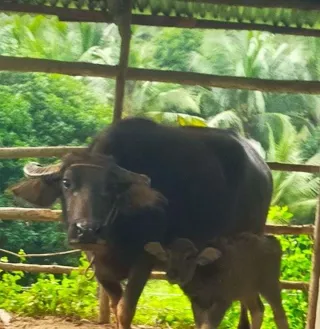
Our Passion
Nestled in the lush, scenic beauty of the Cagayan Valley, our coconut farm spans 13 acres (approximately 5.26 hectares) in San Juan, Ilagan, Isabela, Philippines. We are proud to grow and cultivate premium coconuts and coconut seedlings that thrive in the rich, fertile soils of Isabela.
About Us
About Coconut Farming

Coconut farming is a vital part of agriculture in the Philippines, with coconuts being a versatile crop used for food, oils, and even construction materials. At our farm, we maintain sustainable practices, ensuring that our coconuts are of the highest quality for both local and international markets. We also offer seedlings for those interested in starting their own coconut farm.



About Ilagan, Isabela, and the Cagayan Valley
Ilagan, the capital of Isabela, is a thriving city with a rich history dating back to its founding in 1581. Isabela itself is known as the “Rice Granary of the North,” but it is also famous for its corn, and tobacco production. The Cagayan Valley region is home to diverse ecosystems, bordered by the Sierra Madre Mountains and the mighty Cagayan River, which provides vital irrigation to the area.
Proximity and Access

Our farm is conveniently located near major transport routes. We are about a 45-minute drive from Tuguegarao Airport (TUG), which offers flights to and from Metro Manila. Additionally, Ilagan is about 8 hours drive from Manila. The nearby Cagayan and Pinacanauan Rivers also provide natural beauty and resources for the area.



Contact Us
If you're interested in purchasing our coconuts or seedlings, we'd love to hear from you! Please reach out via:
Email: [email protected]
We look forward to working with you and sharing the bounty of our farm with the world!
Frequently Asked Questions
How long does it take for a coconut tree to start producing coconuts?
Coconut trees typically begin producing fruit between 6 to 10 years after planting, depending on the variety and growing conditions. Dwarf varieties tend to bear fruit earlier, around 3 to 6 years, while tall varieties take a bit longer. Trees reach peak production around 15 to 20 years of age.
How often can coconuts be harvested?
Coconut trees can produce coconuts all year round. Mature trees usually produce a new bunch of coconuts every month. Each bunch typically contains 5 to 12 coconuts, depending on the health of the tree and environmental conditions. Harvesting can be done every 45 to 60 days.
What are the best growing conditions for coconut trees?
Coconut trees thrive in tropical climates, particularly in areas with high humidity, consistent rainfall, and plenty of sunlight. They prefer well-drained sandy or loamy soils but can adapt to a variety of soil types. Coconut trees grow best in areas near coastal regions where the climate remains warm and humid year-round.
What products can be made from coconuts?
Coconuts are incredibly versatile. They can be used to produce coconut oil, coconut water, copra, coconut milk, desiccated coconut, and coir (fiber from the husk). The coconut tree itself provides timber, and the leaves can be used for thatching roofs or making handicrafts.
What is the average yield of a coconut tree per year?
On average, a healthy coconut tree can produce around 50 to 100 coconuts per year, depending on the variety, care, and environmental conditions. Some high-yielding varieties can produce even more, especially when grown under optimal conditions.
How much space is needed between coconut trees when planting?
Coconut trees require plenty of space to grow and spread their roots. On average, it is recommended to plant coconut trees with at least 8 to 10 meters of space between them. This allows the trees to receive adequate sunlight and nutrients from the soil without competing with each other.
What is the lifespan of a coconut tree?
Coconut trees have long lifespans and can live for up to 80 to 100 years under the right conditions. However, their most productive years are typically between 15 and 60 years of age, after which the yield may gradually decrease.
How do you care for coconut seedlings?
Coconut seedlings need plenty of sunlight and water, especially during their first few years of growth. It’s important to keep the soil well-drained to avoid waterlogging, which can damage the roots. Regularly removing weeds and applying organic fertilizers will help the seedlings grow strong and healthy.
What pests and diseases affect coconut trees?
Common pests that affect coconut trees include coconut rhinoceros beetles, red palm weevils, and coconut leaf caterpillars. Diseases such as lethal yellowing and bud rot can also impact tree health. Regular monitoring, using organic pesticides, and maintaining a clean, healthy environment around the trees can help prevent these issues.
What is sustainable farming?
Sustainable farming refers to agricultural practices that aim to meet the current food and farming needs while preserving resources for future generations. It involves methods that promote environmental health, economic profitability, and social and economic equity.
Sustainable farming focuses on:
Soil Health: Using crop rotation, organic fertilizers, and reduced tillage to maintain fertile, nutrient-rich soil.
Water Conservation: Efficient irrigation systems and rainwater harvesting help preserve water resources.
Biodiversity: Planting a variety of crops to enhance ecosystem diversity and reduce the risk of pests and diseases.
Minimal Chemical Use: Reducing or eliminating the use of synthetic pesticides and fertilizers to avoid pollution and maintain the health of the surrounding environment.
Energy Efficiency: Using renewable energy sources and reducing the carbon footprint of farming operations.
Animal Welfare: Ensuring humane treatment of farm animals through ethical practices.
Community and Economy: Supporting local economies and providing fair wages to workers.Sustainable farming is designed to balance productivity with environmental care, ensuring long-term viability of both farms and natural ecosystems.

